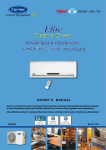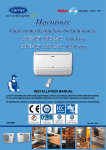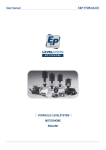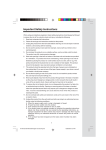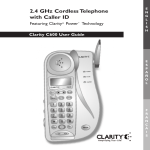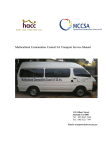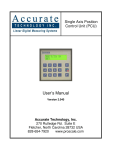Download Carrier 53VMCT 18H-24H-30H-36H Specifications
Transcript
R22 220-240V ~ 50Hz 1Ph Harmony Floor / Under Ceiling Split Air Conditioners 53VMCT 18C-24C-30C-36C Cool Only 53VMCT 18H-24H-30H-36H Heat Pump O W N ER’S MANUAL Carrier is committed to continuously improving its products according to national and international standards to ensure the highest quality and reliability standards, and to meet market regulations and requirements. All specifications subject to change without prior notice according to Carrier policy of continuous development. Quality Management System 03502826 ISO 9001 : 2008 Certificate No.: QS-5519HH Enviromental Management System ISO 14001 : 2004 Certificate No : 12 104 30334 TMS Safety Management System BS OHSAS 18001 : 2007 Certificate No : 12 116 30334 TMS Rev. (0) - 2013 220-240V ~ 50Hz 1Ph R22 Harmony Floor / Under-Ceiling Split Systems IAQ LE Efficient AMS Smart LCD Wireless Control Auto Mode 3 Min. 3 Minutes Time Delay Self diagnostic function Harmony Design Efficient Fans Smart Airflow Independent Dehumidification Anti Freezing Anti-Freezing Protection Refrigerant Leak Detection LED Display Efficient Coils Vertical Air Flow Auto Swing Sleep Function Cold Draft Protection Easy Flexible Installation Efficient Operation Inner Groove Copper Tubing Horizontal Air Flow Manual Direction Timer Functions High Temp. Protection Easy Fast Service & Maintenance Tropical Compressor Super Quiet Auto Fan Speed Auto Restart Function Defrost Protection Washable Air Filters Efficient Anti-dust Filters AMS Auto High Temp. Protect Thank you for selecting Carrier Air Conditioner Harmony split system is the optimum air conditioning solution for places which require floor or under-ceiling installations, elegant appearance and ultimate comfort combined with efficient and quiet operation, optimum air distribution, and efficient Indoor Air Quality (IAQ). Harmony is the very latest in slim line technology. CONTENTS PAGE NO. 1. GENERAL INFORMATION 1 2. SYSTEM SAFETY PROTECTIONS 2 3. TIPS OF ENERGY SAVING AND OPTIMUM COMFORT 3 4. SPLIT SYSTEM DESCRIPTION 5 5. CONSIDERATIONS FOR REMOTE CONTROL 6 6. DESCRIPTION OF LEDS & EMERGENCY BUTTON 7 7. USE OF REMOTE CONTROL 9 8. AIR FILTERS CLEANING 22 9. INDOOR COIL CLEANING 23 10. PERIODICAL CHECKS 24 11. 24 CONSIDERATIONS BEFORE A LONG SHUTDOWN PERIOD OF AIR CONDITIONER 12. OPERATION TIPS 25 13. TROUBLE SHOOTING TIPS 26 1. GENERAL INFORMATION PRECAUTIONS Installing and servicing of air conditioning equipment can be hazardous due to system pressure and electrical components. Only trained and qualified service personnel should install or service this equipment. Untrained personnel can perform basic maintenance function such as cleaning coil and filters. Trained service personnel should perform all other operations. When working on air conditioning equipment, observe precautions in the literature, tags and labels attached to the unit. WARNINGS • The operating voltage of electrical power supply should be within the voltage mentioned on unit nameplate data. • The capacity of electrical kWh counter should be larger than the operating currents required for air conditioner(s) and any other electrical domestic appliances in use simultaneously from the same supply. • The installation of electrical distribution box after the electrical KWH counter is necessary to properly distribute the electrical loads. The electrical distribution box should be equipped with circuit breakers according to the electrical loads. For each installed air conditioner, a separate circuit breaker with its own overload should be installed on the electrical distribution box. • The installation of two-pole automatic circuit breaker is necessary to operate the air conditioner. The circuit breaker must be installed to be far away from any flammable materials (curtains…etc.). The circuit breaker size must be suitable for air conditioner. • Disconnect the electrical mains supply prior to any maintenance operations or prior to handling any internal unit parts. • The manufacturer declines any liability for damage resulting from modifications or errors in the electrical or refrigerant connections, made during the installation, or from the improper use of this equipment. This will void the unit warranty immediately. • Failure to observe electrical safety codes may cause a fire hazard in case of short circuits. • This system will only work safety and correctly, if installed and tested by qualified personnel. • Do not open the electronic remote controller to avoid possible damage. In case of malfunction contact a qualified service engineer. • The unit contains rotating equipment (fan). Ensure that this is out of reach for children. • Be conscious of the room temperature and general comfort, particularly when this is used near children, senior or handicapped people. • For correct use, the air conditioner must operate within the temperature limits indicated in the table “Operating Limits” included in the installation manual. Incorrect use of the system outside these limits may cause malfunction and dripping water. • Controller batteries contain polluting elements. When exhausted, they must be disposed of in accordance with local requirements. • Do not switch off the split system by disconnecting the electric power supply. The system must always be switched off using the remote control. (1) 2. SYSTEM SAFETY PROTECTIONS The air conditioner is equipped with complete safety protections to ensure safe operation of air conditioner at different operating conditions : 2.1 Safety protections for Cool Only System Auto Restart Feature with backup memory. When the power failure is happened during the air conditioner operation, the microprocessor of printed circuit board will memorize the operation setting. After the power is recovered, the air conditioner operates automatically ( without remote control after elapse of compressor time delay ), according to the previous operation settings. 3 (Three) minutes time delay between compressor turning off and turning on for compressor protection against cycling. Anti-freezing protection of indoor coil when the system is operating in cool mode with excessive dirt on the indoor coil and / or clogged air filters and when the air conditioner is operating in cool mode at low ambient temperature. Smart self-diagnostic function for malfunctions detection for fast easy service and maintenance. Smart refrigerant leak detection by sensitive sensors mounted on the indoor and outdoor coils for fast easy service and maintenance. 2.2 Safety protections for Heat Pump System Auto Restart Feature with backup memory. When the power failure is happened during the air conditioner operation, the microprocessor of printed circuit board will memorize the operation setting. After the power is recovered, the air conditioner operates automatically ( without remote control after elapse of compressor time delay ), according to the previous operation settings. 3 (Three) minutes time delay between compressor turning off and turning on for compressor protection against cycling. Anti-freezing protection of indoor coil when the system is operating in cool mode with excessive dirt on the indoor coil and / or clogged air filters and when the air conditioner is operating in cool mode at low ambient temperature. Cold draft protection when the system is operating in heat mode. When starting heat mode, the fan speed is regulated automatically from the lowest grade to the preset level, according to the temperature rise of indoor coil. This function can prevent cold air blowing out at the beginning of heat modem which avoids the discomfort to the user. High temperature protection of indoor coil when the air conditioner is operating in heat mode. Defrost protection of outdoor coil when the air conditioner is operating in heat mode at very low ambient temperature. Smart self-diagnostic function for malfunctions detection for fast easy service and maintenance. Smart refrigerant leak detection by sensitive sensors mounted on the indoor and outdoor coils for fast easy service and maintenance. (2) 3. TIPS OF ENERGY SAVING AND OPTIMUM COMFORT In Summer • • Keep room temperature to comfort levels. Don’t remain in direct contact with cold air for a long period. This is harmful to health. • Don’t wait until it is too hot. Turn the air conditioner for cooling before that. • Don’t exaggerate on the temperature intensity, too cold. Extreme temperatures are harmful to your health and waste energy. In Winter • • Keep room temperature to comfort levels. Don’t remain in direct contact with warm air for a long period. This is harmful to health. • Don’t wait until it is too cold. Turn the air conditioner for heating before that. • Don’t exaggerate on the temperature intensity, too hot. Extreme temperatures are harmful to your health and waste energy. Keep doors, windows and any other openings closed to COOL mode HEAT mode prevent the conditioned air from escaping and to prevent un conditioned air from entering the space to be air conditioned. When in cooling, avoid direct sun in the room to be airconditioned, if possible shut curtains or shades. Keep doors, furniture or any other obstructions away from blocking return air and / or supply air of the indoor unit to assure maximum efficiency and adequate air circulation. Use SLEEP function during sleep for energy saving, comfortable and healthy sleep during cool mode or heat mode. COOL mode With SLEEP function (3) HEAT mode With SLEEP function TIPS OF ENERGY SAVING AND OPTIMUM COMFORT (Cont.) Ensure a uniform air circulation in the room to be air conditioned Clean periodically air filter of indoor unit Air Filter every two weeks to assure adequate air Return grille circulation and maximum cooling or heating efficiency. Periodic service and maintenance of the air conditioner or upon customer request through carrier or carrier authorized dealer service center. (4) 4. SPLIT SYSTEM DESCRIPTION Sizes 18 - 24 Indoor Unit 6 12 3 7 8 4 5 Outdoor Unit 9 Sizes 30 - 36 7 3 1 2 6 Indoor Unit 10 8 4 Outdoor Unit 5 9 1: 2: 3: 4: 5: Remote control signal receiver. Operating status leds. Supply air flap. Air return grille. Air filter ( behind return grille ). 6: 7: 8: 9: Supply air outlet. Characteristics nameplate. Refrigerant piping lines and electrical cables. Condensate drain line. (5) 5. CONSIDERATIONS FOR REMOTE CONTROL 5-1 HOW TO INSERT BATTERIES : (a) Remove the cover of battery compartment at the back of the remote control by pressing the tab toward outside, in the direction of the arrow. (c) Press the button (at the front of remote control) with an object not sharp to operate the remote control. (b) Mount two batteries size AAA 1.5 Volt supplied with the remote control. Then close the cover of the battery component. Note: During mounting of batteries check battery symbols (+, -) indicated in batteries compartment. NOTES 1. The remote control uses two alkaline batteries (1.5 Volts) . 2. Do not use old batteries or batteries of different types, as this may cause the remote control to malfunction. 3. If you do not use the remote control for more than a few weeks, please remove the batteries. Other wise battery leakage may damage the remote control. 4. The average battery life during normal use is approximately half a year. 5. Replace the batteries when there is no receiving beep coming from the indoor unit or transmission indicator on the remote control fails to light. 6. Batteries should only be replaced after turning OFF the air conditioner. 5-2 INSTRUCTIONS OF USING WIRELESS REMOTE CONTROL 1- The remote control must be directed toward the receiver of indoor unit when pressing the buttons of the desired functions. An acoustical acknowledgement sound (beep) will indicate that signal has been received. 2- Avoid direct sunlight on the receiver of indoor unit, which may interfere with good signal reception and the air conditioner may not work properly. Draw the curtains to avoid direct sunlight. 3- Avoid obstacles obstructions such as curtains, doors or other materials between the remote control and the receiver of indoor unit to avoid blocking the signals from the remote control to the indoor unit. 4- The maximum operating distance for the remote control is approximately 8 meters. 5- Keep the remote control away from water. Do not let the remote control fall down. 6- Never use objects with sharp point to press the button on the remote control. 7- Prevent any liquid from falling into the remote control. 8- If other electric applications react to the remote control, move these applications. 5m maximum (6) 6. DESCRIPTION OF LEDS DISPLAY AND EMERGENCY BUTTON INDOOR UNITS 18 - 24 1 : Green Led 2 : Yellow Led 3 : Red Led 4 : Remote control signal receiver 5 : “Emergency” button Indoor unit LED’s • GREEN LED (1) shows the following conditions: - Fault codes (diagnostic); - During normal operation, the LED is lit. Once a failure occurs, the LED flashes at intervals of 0.5 seconds. The fault code is deduced from the number of times the LED flashes. Between one flash cycle and the next a pause of 5 seconds elapses. If the timer mode is active and the unit is immediately restarted after a stop, this LED flashes until a new signal is sent to the indoor unit. • YELLOW LED (2) shows the operation in timer mode. During this operation in this operating mode, the LED is lit. If the time mode is active and the unit is immediately restarted after a stop, this LED flashes until a new signal is sent to the indoor unit. • RED LED (3) gives the following information: - During normal operation, the LED is OFF; - During defrost the LED is lit; - During the test for wired connection, the LED flashes at 1- second intervals. Button (5) : “EMERGENCY” Can be used when the remote control is lost or inoperative. Use a screwdriver to press the push-button. Emergency operation: When the unit is in the OFF mode and the emergency is pressed for 5 seconds, the system will operate as follows: - Automatic mode. - Temperature preset to 22ºC. - Automatic fan speed. - Louvers set automatically according to operating mode. - Timer Functions are inactive. When a signal is received by the remote control, system operates accordingly. (7) DESCRIPTION OF LEDS DISPLAY AND EMERGENCY BUTTON (Cont.) INDOOR UNITS 30 - 36 1 : Green Led 2 : Yellow Led 3 : Red Led 4 : Remote control signal receiver 5 : “Emergency” button Indoor unit leds • GREEN LED (1) shows the following conditions : - Fault codes (diagnostic); - During normal operation, the LED is lit. Once a failure occurs, the LED flashes at intervals of 0.5 seconds. The fault code is deduced from the number of times the LED flashes. Between one flash cycle and the next a pause of 5 seconds elapses. If the timer mode is active and the unit is immediately restarted after a stop, this LED flashes until a new signal is sent to the indoor unit. • YELLOW LED (2) shows the operation in timer mode. During this operation in this operating mode, the LED is lit . If the time mode is active and the unit is immediately restarted after a stop, this LED flashes until a new signal is sent to the indoor unit. • RED LED (3) gives the following information: - During normal operation, the LED is OFF; - During defrost the LED is lit; - During the test for wired connection, the LED flashes at 1- second intervals. EMEGENCY OPERATION (5) Can be used when the remote control is lost or inoperative. Use a screwdriver to press the push-button. Emergency operation: When the unit is in the OFF mode and the emergency is pressed for 5 seconds, the system will operate as follows: - Automatic mode. - Temperature preset to 22ºC. - Automatic fan speed. - Louvers set automatically according to operating mode. - Timer Functions are inactive. When a signal is received by the remote control, system operates accordingly. (8) 7. USE OF REMOTE CONTROL CLOCK ADJUSTING FUNCTION Initial Setting or the Clock When batteries are inserted in the remote control, the clock panel will display ‘’12:00’’ and being to flash. Setting the clock Before you start operating the air conditioner, set the clock of the remote control using the procedures given in this section. The clock display on the remote controller will show the time regardless of whether the air conditioner is in use or not. 1. With the remote control ON or OFF, Press CLOCK for about 3 seconds, the clock time display will start to flash. 2. TEMP. button • Press this button to set time. Forward Backward • Each time you press the button, the time moves forward or backward by one minute depending on which side you press. The time alters as quickly as you press the button. • Keep pressing the button without releasing, the time moves forward or backward by 10 minutes depending on which side you press. 3. CLOCK button When the right time is achieved, press the CLOCK button or release the or and wait for 3 seconds, the clock time stops flashing and the clock starts 4. Readjusting the Clock Press the CLOCK button on the remote controller for about 3 seconds, the time of the clock display will start to flash. To set the new time, follow 1 and 2 of "Initial Setting of the Clock". NOTES * The clock time must be set before operating TIME functions. * The clock time cannot be adjusted during TIME operation. * Clock accuracy is within 15 seconds per day. 2 1 3 CAUTIONS Static electricity or other factors (voltage transients ) can cause remote controller clock initialise. If your remote controller is initialised readjust the clock before you start operation. (9) USE OF REMOTE CONTROL (Cont.) COOL MODE START 1. Press MODE button to select COOL mode on the remote control display. 2. Press TEMP buttons or to select the set temperature on the remote control display. Set desired temp. between 17°C and 30°C. 3. Press FAN SPEED button to select the desired fan speed on the remote control display. 1 4 3 4. Press ON/OFF button to start the air conditioner. ON symbol appears on the remote control display. OPERATION led will illuminate on the display panel of indoor unit. COOL mode starts after approximately 3 minutes STOP If you want to stop the air conditioner, Press ON/OFF button again. NOTES • If the room temperature is higher than the selected temperature, the system will start COOL mode. • If the room temperature is equal to or less than the selected temperature, the system will stop COOL mode. • If you use AUTO fan speed with COOL mode, the fan speed changes automatically to low or medium or high speed based on the temperature difference between setting temperature and room temperature. ( 10 ) 2 2 USE OF REMOTE CONTROL (Cont.) HEAT MODE START 1. Press MODE button to select HEAT mode on the remote control display. or to select the set 2. Press TEMP buttons temperature on the remote control display. Set desired temp. between 17°C and 30°C. 3. Press FAN SPEED button to select the desired fan speed appears on the remote control display. 1 4 3 4. Press ON/OFF button to start the air conditioner. ON symbol appears on the remote control display. will illuminate OPERATION led on the display panel of indoor unit. HEAT mode starts after approximately 3 minutes STOP If you want to stop the air conditioner, Press ON/OFF button again. NOTES • If the room temperature is lower than the selected temperature, the system will start HEAT mode. • If the room temperature is equal to or higher than the selected temperature, the system will stop HEAT mode. • If you use AUTO fan speed with HEAT mode, the fan speed changes automatically to low or medium or high speed based on the temperature difference between setting temperature and room temperature. ( 11 ) 2 2 USE OF REMOTE CONTROL (Cont.) AUTO MODE START 1. Press MODE button to select AUTO mode on the remote control display. or to select the 2. Press TEMP buttons set temperature on the remote control display. Set desired temp. between 17°C to 30°C . 1 4 3 3. Press FAN SPEED button to select the desired fan speed appears on the remote control display. 4. Press ON/OFF button to start the air conditioner. ON symbol appears on the remote control display. OPERATION led will illuminate on the display panel of indoor unit. AUTO mode starts after approximately 3 minutes STOP If you want to stop the air conditioner, Press ON/OFF button again. NOTES 1. For Heat Pump System When Auto mode is activated, the air conditioner changes the operation mode automatically to cool or heat or fan only mode and also changes fan speed to auto speed by sensing the temperature difference between room temperature and set temperature. 2. For Cool Only System When Auto mode is activated, the air conditioner changes the operation mode automatically to cool or fan only mode and also changes fan speed to auto speed by sensing the temperature difference between room temperature and set temperature. 3. In the Auto mode, you cannot switch the fan speed. It has already been automatically controlled. 4. If the Auto mode is not comfortable for you, the desired mode can be selected manually. 5. If the Eco function is activated when the unit is operating in Auto mode, the fan speed will change into Low speed mode immediately. ( 12 ) 2 2 USE OF REMOTE CONTROL (Cont.) DRY MODE START 1. Press MODE button to select DRY mode on the remote control display. or , to select the 2. Press TEMP buttons set temperature the remote control display. Set desired temp. between 17°C to 30°C . 1 3 3. Press ON/OFF button to start the air conditioner. appears on the ON symbol remote control display. OPERATION led will illuminate on the display panel of indoor unit. DRY mode starts after approximately 3 minutes STOP If you want to stop the air conditioner, Press ON/OFF button again. NOTES • In DRY mode, you can not switch the indoor indoor fan speed. The indoor fan speed will be automatically selected AUTO. • The DRY mode will automatically select the drying operation based on the difference between the set temperature and the actual room temperature. • The temperature is regulated while dehumidifying by repeating turning on and off of the cooling operation or fan only. ( 13 ) 2 2 USE OF REMOTE CONTROL (Cont.) FAN ONLY MODE START 1. Press MODE button to select FAN mode on the remote control display. 2. Press FAN SPEED button to select the desired fan speed on the remote control display. 3. Press ON/OFF button to start the air conditioner. 1 3 2 appears ON symbol on the remote control display. OPERATION led will illuminate on the display panel of indoor unit. FAN ONLY mode starts immediately. STOP If you want to stop the air conditioner, Press ON/OFF button again. NOTES • In FAN mode, the unit will start immediately. • FAN mode does not control temperature. The setting temperature is not displayed on the remote control display. ( 14 ) USE OF REMOTE CONTROL (Cont.) SWING FUNCTION Press button SWING repeatedly to choose the following flap : The louver will continuously swing up and down. “Swing” always assures optimal even air distribution in the room. Swing Range COOL HEAT • In Cool or Dry or Fan mode, the louver will swing in cooling range. • In Heat mode, the louver will swing in heating range. Note: If you want to cancel swing function Press button SWING at the desired flap position AIR DIRECTION FUNCTION The air conditioner automatically adjusts the vertical supply air direction in accordance with the operating mode. To set the vertical supply air direction (Up- Down) • Perform this function while the unit is in operation. • Keep pressing the AIR DIRECTION button on the remote control to move the louver to the desired. • In subsequent operations, the vertical air flow is automatically set in the direction to which you adjusted the louver by pressing the AIR DIRECTION button. Left and Right Control If you want to adjust the direction of the discharge air to left or right, adjust the vertical louver with the handle after opening the flap. NOTES: • Please do not fix the flap for a long time, as this position minimizes air circulation resulting in uneven room temperature. • Please avoid the discharge air being directed towards the occupants for a long period of time. • Do not adjust the flap by the hand during SWING operation because it may damage the air swing function. ( 15 ) USE OF REMOTE CONTROL (Cont.) SLEEP Function HEALTHY SLEEP TIMER FUNCTION Sleep function is useful when you go to sleep. When Sleep function is activated, the air conditioner automatically controls the selected temperature and consequently controls the room temperature to avoid overcooling or overheating and to have comfortable and healthy sleep. SLEEP function with COOL Mode If you want to operate SLEEP function with Cool mode to save energy and maintain the most comfortable temperature during COOL mode, apply the following steps : Start: Press SLEEP button to activate SLEEP function Then the logo of function show on display of remote control. • The fan speed will automatically change to low speed. • The set temperature will be automatically increased by 1°C after 1 hour after COOL mode is selected. • Then the set temperature will be automatically increased by another 1°C after additional 1 hour. • This new temperature will be maintained. Stop: If you want to cancel SLEEP function, press any other button. SLEEP function with COOL mode SLEEP function with HEAT Mode If you want to operate SLEEP function with Cool mode to save energy and maintain the most comfortable temperature during HEAT mode, apply the following steps : Start: Press SLEEP button to activate SLEEP function function show on display of remote control. Then the logo of • The fan speed will automatically change to low speed. • The set temperature will be automatically decreased by 1°C after 1 hour after HEAT mode is selected. • Then the set temperature will be automatically decreased by another 1°C after additional 1 hour. • This new temperature will be maintained. Stop: If you want to cancel SLEEP function, press any other button. NOTE SLEEP function is only available with COOL, HEAT and AUTO mode. ( 16 ) SLEEP function with HEAT mode USE OF REMOTE CONTROL (Cont.) TIMER ON FUNCTION ( Off → Start Operation ) TIMER ON function is useful when you want to start automatically the air conditioner at a desired setting time when you wake up in the morning or when you return home. Example: To automatically start the air conditioner at 6:00 in the morning Proceed with following steps : (1) Press TIMER button until the remote control display shows. TIMER ON indicator and the last setting time which is flashing. Now it is ready to reset the setting time of TIMER ON function. (2) To set the desired time, Press TEMP. button or (3) (Forward) (Backward) unit the time 6:00 is displayed. Each time you press there the button, the time moves forward or backward by 10 minutes depending on which one you press. The time alters as quickly as you press the button. After setting the time for TIMER ON function, the TIMER led will illuminate on the display panel of the indoor unit. TO CANCEL TIMER ON FUNCTION Press CANCEL button if you want to cancel TIMER ON setting. TO CHANGE TIMER ON SETTING Perform steps 1, 2 and 3 to change TIMER ON setting. CAUTION When you select the timer operation, the remote control automatically transmits the timer signal to the indoor unit at the specified time. Therefore, keep the remote control in a location from which it can transmit the signal to the indoor unit properly. The effective operation time set by remote control is limited in 24 hours. Start Off Set ( 17 ) USE OF REMOTE CONTROL (Cont.) TIMER OFF FUNCTION ( On → Stop Operation ) TIMER OFF function is useful when you want to stop automatically the air conditioner at a desired setting time after you go to bed. Example : To automatically stop the air conditioner at 23:00 in the evening proceed with the following steps : (1) Press TIMER button until the remote control display shows. TIMER OFF indicator and the least setting time which is flashing Now it is ready to reset the setting time of TIMER OFF function (2) To set the desired time, Press TEMP. button (Backward) unit the time 23:00 is displayed. (Forward) • Each time you press the button the time moves forward or backward by 10 minutes depending on which one you push. The time alters as quickly as you press the button. (3) After setting the time for TIMER ON function, the TIMER led will illuminate on the display panel of the indoor unit is illuminated. TO CANCEL TIMER ON FUNCTION If you want to cancel TIMER OFF setting, Press CANCEL button. TO CHANGE TIMER ON SETTING Perform steps 1, 2 and 3 to change TIMER OFF setting. CAUTION When you select the timer operation, the remote control automatically transmits the timer signal to the indoor unit at the specified time. Therefore, keep the remote control in a location from which it can transmit the signal to the indoor unit properly. The effective operation time set by remote control is limited in 24 hours. Stop On Set ( 18 ) USE OF REMOTE CONTROL (Cont.) COMBINED TIMER ON → TIMER OFF FUNCTION ( Off → Start Operation → Stop Operation ) You can use this setting to automatically start operation of the air conditioner before you wake up and automatically stop it after you leave the home. Example: If you want to start operation of the air conditioner at 6:00 AM the next morning, and stop at 8:00 AM proceed as follows: Start Stop Off Set 6:00 8:00 1. Press TIMER button until TIMER ON indicator is displayed and setting time is flashing. 2. Use TEMP/TIME button to display "6:00" beside the TIMER ON indicator. Wait 3 seconds, the TIMER ON time will be registered. 3. Press TIMER button again until TIMER OFF indicator is displayed and setting time is flashing. 4. Use TEMP/TIME button to display "8:00" on the TIMER OFF indicator. 5. Wait 3 seconds until the setting time stops flashing and this function is activated. NOTES If you want to cancel ON or OFF timer setting, press CANCEL button. The timer function (ON or OFF ) which in time is closest to the actual time will be activated first. If the same time is set for both ON and OFF timers, no timer operation is performed. Also, the air conditioner may stop operating. ( 19 ) USE OF REMOTE CONTROL (Cont.) COMBINED TIMER OFF → TIMER ON FUNCTION ( On → Stop Operation → Start Operation ) You can use this setting to automatically stop the air conditioner after you go to sleep and start it automatically again in the morning when you wake up or you return home. Example: Now it is 20: o’clock in the evening If you want to automatically stop operation at 23:00 PM and automatically start again at 6:00 AM in the next morning with the same operating mode, proceed as follows: Start Stop On Set 23:00 6:00 To start the air conditioner at 6:00 the next morning, and stop it at 8:00. 1. Press TIMER button, until TIMER OFF indicator is displayed and the setting time is flashing. 2. Use the TEMP/TIME button to display "23:00" beside the TIMER OFF indicator of the remote control. Wait 3 seconds, the TIMER OFF time will be registered. 3. Press TIMER button again until TIMER ON indicator is displayed and setting time is flashing. 4. Use TEMP/TIME button to display "6:00" beside the TIMER ON indicator. 5. Wait 3 seconds until the setting time stops flashing and this function is activated. NOTES If you want to cancel ON or OFF timer setting, press CANCEL button. The timer function (ON or OFF ) which in time is closest to the actual time will be activated first. If the same time is set for both ON and OFF timers, no timer operation is performed. Also, the air conditioner may stop operating. ( 20 ) USE OF REMOTE CONTROL (Cont.) RESET Function F/C Function When you press the recessed RESET button, all current settings are cancelled and return to original factory settings. • The clock time “12:00” will flash • The mode displays “AUTO” • The fan speed displays “AUTO” • The temperature displays “24” Note : You will need to reprogram the clock setting after Pressing RESET button Used to select / display temperature settings in either “ Celsius ” or Fahrenheit. Press this button to select either the Celsius or Fahrenheit scale. LOCK Function 1. Use LOCK function when you want to prevent settings from being changed accidentally. 2. When you press TEMP. ▲and ▼ buttons as the same time, all current settings are locked in and the remote control does not accept any operation except that of the LOCK. will appear on the bottom right 3. A LOCK symbol hand sides of the remote control display when the LOCK function is activated. 4. If you want to cancel LOCK function, Press again TEMP. ▲and ▼ buttons as the same time. ( 21 ) 8. AIR FILTERS CLEANING WARNING: It is necessary to stop the air conditioner and disconnect the power supply before cleaning air filters. - The air filters supplied with the unit are high-efficiency washable and recyclable filters. To establish, how frequently these should be cleaned, the operating conditions must be taken in to account. - REMOVAL OF AIR FILTERS FOR CLEANING: - Indoor Units 18 - 24 Indoor Units 30 - 36 To remove air filters To remove air filters 1. Open the return grille without removing the two screws and the central clamp from their position. 1. Open the return grille without removing the two screws and the central clamp from their position 2. Remove filters 2. Remove air filters for cleaning. - CLEANING OF STANDARD AIR FILTERS: 3. First clean the filter with a vacuum cleaner every month. And Rinse filter under running water, and dry it. 4. After cleaning, put the filters back in the correct positions. 3. First clean the filter with a vacuum cleaner every month. And Rinse filter under running water, and dry it. 4. After cleaning, put the filters back in the correct positions. Notes: (1) After cleaning, put the filters back in the correct positions. (2) Before operating the air conditioner, check that air filters are in their places inside unit. ( 22 ) 9. INDOOR UNIT CLEANING Turn the unit off and switch the mains supply off. Use only a clean, damp and soapy cloth. Do not pour any liquids on the unit. Do not use flammable liquid, solvents or abrasive powders: these can damage the casing. Avoid any contact with sources of heat, as hot air can damage the unit casing. Clean the infrared control using a damp cloth. 9-2 INDOOR COIL CLEANING It is recommended to clean the coil at least at the beginning of each cooling season or when necessary; turn the unit off first. • Use a vacuum cleaner or a long-bristle brush to avoid damage to the coil fins. • Watch the fin edges to avoid injury. • Damage to the fins may cause reduced coil efficiency resulting in increased running costs. Use of flames, liquid or aerosol solvents must be avoided. Use of these substances will cause serious damage to the panels and electric parts. ( 23 ) 10. PERIODICAL CHECKS WARNING: It is necessary to stop the air conditioner and disconnect the power supply before performing service and maintenance operations. For a good operation of the air conditioner it is recommended to carry out periodic service and maintenance of the air conditioner or upon customer request through Carrier or Carrier authorized dealer. Recommended service and maintenance works and intervals may vary depending on the installation environment, e.g. dusty zones, etc. see below table : Indoor Unit Every Month ●(1) (3) Clean air filters Clean drain pipe (2) Change remote control batteries (4) Outdoor Unit Every Month (2) Clean outdoor coil Blow air over electric parts (2) Check electric connection tightening (2) Clean fan wheel (2) Check fan tightening (2) Clean drain pan (2) Every Year ● ● Every Year ● ● ● ● ● ● NOTES (1) (2) (3) (4) Increase frequency in dusty zones. Service and maintenance works to be carried out by qualified service personnel. Cleaning air filters can be done by customer every month. Changing batteries of remote control can be done by customer every year. 11. CONSIDERATIONS BEFORE A LONG SHUTDOWN PERIOD OF AIR CONDITIONER Keep the indoor unit in operation for half a day in the ventilation (fan only) mode in order to dry all internal parts. Switch electric mains supply off. Take batteries out of the remote control. Clean indoor and outdoor units. Clean the air filters and reposition them in the unit. ( 24 ) 12h 12. OPERATION TIPS The following events may occur during normal operation of the air conditioner: 1. A slight white mist (water vapor)coming out from the indoor unit during cooling A white mist may generate due to a large temperature difference between air inlet and air outlet on COOL mode in an indoor environment that has a high relative humidity. The cool air from the indoor unit is coming into contact with the room air. A white mist may generate due to moisture generated from defrosting process when the air conditioner restarts in HEAT mode operation after defrosting. 2. Low noise of the air conditioner You may hear a low hissing sound when the air conditioner is running or has just stopped running. This sound is the sound of the refrigerant beginning to circulate or an adjustment of the refrigerant pressures after stopping. You can also hear a low short "squeak" when the indoor unit is in operation or when it has stopped. These are generally due to the temperature changes on the plastic parts ( expansion or contraction ). A noise may be heard due to louver restoring to its original position when power is first turned on. 3. Dust is blown out from the indoor unit. This is a normal condition when the air conditioner has not been used for a long time or during first use of the unit. 4. Unpleasant smells coming out from the indoor unit. Unpleasant smells can be caused by substances accumulated in the air filters of indoor unit. In this case, you must switch the system off and air filters must be cleaned. Restart the unit in ventilation ( fan only ) mode and open windows to change the room air, 5. The air conditioner turns to FAN only mode from COOL or HEAT. When indoor temperature reaches the temperature setting on air conditioner compressor will stop automatically the ,and the ,air conditioner turns to FAN only mode. The compressor will start again when the indoor temperature rises on COOL mode or falls on HEAT mode (only for heat pump system) to the set point. 6. Dripping water may generate on the surface of the indoor unit (when cooling in a high relatively humidity higher than 80%). Adjust the horizontal louver to the maximum air outlet position and select HIGH fan speed. 7. Heating mode For. The air conditioner draws in heat from the outdoor unit and releases it via the indoor unit during heating operation. When the outdoor temperature falls, heat drawn in by the air conditioner decreases accordingly. At the same time, heat loading of the air conditioner increases due to larger difference between indoor and outdoor temperature. If a comfortable temperature can't be achieved by the air conditioner, we suggest you use a supplementary heating device. 8. Mist (water vapor) coming out from the outdoor unit during heating It is normal in heat pump operation when defrost is automatically activated during heating operation at very low ambient. 9. Lightning or a car wireless telephone operating nearby may cause the unit to malfunction. Disconnect the unit with power and then re-connect the unit with power again. Push the ON/OFF button on the remote controller to restart operation. ( 25 ) 13. TROUBLE SHOOTING TROUBLE After batteries have been placed into the remote control, the display is not lit. When pressing the recessed clock adjustment button, hour figures on display do not flash. When pressing any button, all symbols appear on display. REASON Batteries are exhausted or have the wrong polarity. ACTION Replace batteries or check polarity. Recessed button has not been pressed correctly. Press with a round point, avoid exerting strong pressure Recessed button for time setting is blocked due to excessive pressure during use. Remote control has been irreversibly damaged. When pressing start button, unit Main switch is OFF. does not acknowledge signal Remote control batteries are with a beep. exhausted. Remote control has not been OR pointed correctly to the receiver of indoor unit. When pressing stop button, unit There are obstacles (curtains, does not acknowledge signal walls, etc.) between the remote with a beep. control and the indoor unit Receiver on the indoor unit or the OR remote control is under intense sun radiation. When pressing any function Signal transmission is button, the remote control shows obstructed by severe the function requested on the interference from an display, but unit does not electromagnetic field. acknowledge signal receipt with a beep and does not carry out the function. ( 26 ) Check and repair. Replace with a new one. Switch it to ON position. Replace batteries. Turn remote control OFF and repeat the operation in the correct direction. Repeat the operation after having removed the obstacles. Avoid direct sun on the unit, shut curtains or shades. Avoid sending signals when computers or household appliances (Food processors, coffee makers, etc.) are operating close by cellular or cordless telephones may also interfere with the control. TROUBLE SHOOTING (Cont.) TROUBLE REASON Air conditioner will not start. Main supply switch is OFF Fuses or main switch are blown Protection against frequent compressor cycling is ON Selected temperature is higher than the room temperature in the cooling mode (or lower in the heating mode). Air conditioner is not supplying Air flow cannot circulate freely enough cooling. Dirty filters reduce air quantity circulating. Doors and/or windows are open. Fan speed has been set to “Low” Air flow direction is not correct Selected temperature is higher than the room temperature in the cooling mode. Air conditioner is not supplying Air flow cannot circulate freely enough heating. Dirty filters reduce air quantity circulating. Doors and/or windows are open. Fan speed has been set to “Low” Air flow direction is not correct Green led on the display panel of indoor unit is showing a malfunction Selected temperature is Lower than the room temperature in the heating mode. System malfunction. Contact service center after having made the following checks: • Air filters are clean. • Air circulation is not obstructed. • Outdoor unit coil is not obstructed with a severe reduction of air circulation. ( 27 ) ACTION Switch to ON Replace fuses Wait for 3 minutes. Correct selected temperature. Remove obstructions. Clean air filters Close doors and windows Set fan speed at high speed. Adjust airflow direction as per the mode chosen. Correct selected temperature. Remove obstructions. Clean air filters Close doors and windows Set fan speed at high speed. Adjust airflow direction as per the mode chosen. Correct selected temperature. Refer to the installation manual for fault code reading to be notified to service center. Restart air conditioner after having corrected the faults. Harmony 18K - 24K 30K - 36K Floor / Under-Ceiling Split Systems 2 1 3 Wireless Remote Control AUTO COOL DRY HEAT FAN 5 4 9 SET TEMP. o Display of Remote Control CLOCK TIMER ON TIMER OFF SPEED AUTO LOW MED HIGH 6 7 3 ON/OFF indicator 4 SET TEMP. indicator 10 5 Temperature unit of measurement (ºC or ºF) 6 Current time 7 ON TIMER or OFF TIMER 8 FAN SPEED indicator 8 1 2 Signal transmission indicator Operating mode indicator AUTO Automatic (heat pump model only) COOL Cooling and dehumidification DRY Dehumidification only HEAT Heating (heat pump models only) FAN Ventilation (fan only) 18K - 24K AUTO FAN SPEED indicator AUTO LOW FAN SPEED indicator LOW MED FAN SPEED indicator MED HIGH FAN SPEED indicator HIGH 9 SLEEP function indicator 10 LOCK function indicator Display of Indoor Unit OPERATION green led TIMER function yellow led Cold Draft or Defrost red led Remote control signal receiver 30K - 36K Cold Draft or Defrost red led TIMER function yellow led OPERATION green led Remote control signal receiver Emergency switch Harmony Floor / Under-Ceiling Split Systems 18K - 24K 30K - 36K Wireless Remote Control Control Buttons 1 MODE selection button 2 Decrease temperature button 3 Increase temperature button 4 FAN SPEED selection button 5 ON/OFF button 6 SWING horizontal flap button 7 AIR DIRECTION horizontal flap button 8 SLEEP function button 9 CLOCK adjusting button 10 TIMER ON or TIMER OFF function button 11 CANCEL TIME function button 12 LED DISPLAY function button 13 RESET function button 14 F/C function button DISPLAY 1 5 4 8 7 6 12 13 14 3 2 9 10 11
































